
current / archive / issues / faq / RSS feed / twitter /
Blog Archive: September 2020
A Deal With DarkothAfter all the excitement of the last two instalments, which were packed FULL of Doctor Doom, we now get back into a run of comics where he just pops up in flashbacks or other very brief cameos. This seems to happen an awful lot for Doctor Doom, and it makes me wonder whether this is just the case for him, or whether it happens for other characters do it too? I'd imagine that a character with their own regular series, like Hulk or Spider-man, would be the main lead in most cases - at least compared to how many times they appear in flashbacks or cameos, but it would be interesting to find out.
That, however, is a job for the far future, or hopefully even for someone else! For today we're looking at with this rather odd story in which Mephisto devises one of his usual extremely convulted plans, this time with the intent of harassing Thor. It all starts with Mephisto sitting in Hell, watching Thor's alter-ego Don Blake recruiting a patient to be his new secretary.
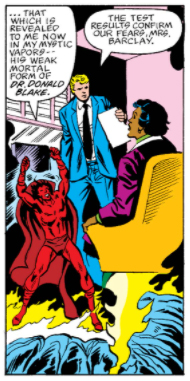 Now, maybe it's just me being even more mephistophelean than Mephisto, but surely knowing Thor's secret identity would provide much more useful ways to destroy his life than whatever crazy plan gets cooked up in the rest of the story? The bright red lord of hades doesn't seem to think so, and instead enacts a crazy plan which involves resurrecting Darkoth The Death Demon and sending him in for a punch-up. Darkoth doesn't want to do this because, apart from anything else, he's a good guy with nothing against Thor. He's also upset because Mephisto has somehow managed to steal him from heaven in what must surely be an appalling administrative cock-up by the forces of good.
Now, maybe it's just me being even more mephistophelean than Mephisto, but surely knowing Thor's secret identity would provide much more useful ways to destroy his life than whatever crazy plan gets cooked up in the rest of the story? The bright red lord of hades doesn't seem to think so, and instead enacts a crazy plan which involves resurrecting Darkoth The Death Demon and sending him in for a punch-up. Darkoth doesn't want to do this because, apart from anything else, he's a good guy with nothing against Thor. He's also upset because Mephisto has somehow managed to steal him from heaven in what must surely be an appalling administrative cock-up by the forces of good.
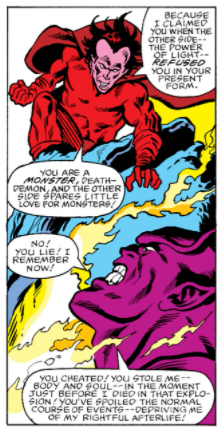 It's here that Doom appears, in a recap of Darkoth's origin story.
It's here that Doom appears, in a recap of Darkoth's origin story.
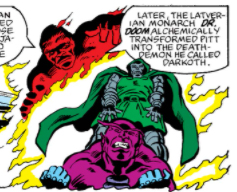 The rest of the story is sadly Doom-free. Darkoth is sent to fight Thor in exchange for the safety of his son, but can't bring himself to do it. Mephisto uses Special Hell Magic to force him to be evil but Darkoth fights back and eventually begs Thor to kill him again so he can properly die this time and go to heaven. Thor agrees, reluctantly, and the whole tale is wrapped up by Thor reverting to Don Blake and offering Darkoth's child to his new secretary to adopt.
The rest of the story is sadly Doom-free. Darkoth is sent to fight Thor in exchange for the safety of his son, but can't bring himself to do it. Mephisto uses Special Hell Magic to force him to be evil but Darkoth fights back and eventually begs Thor to kill him again so he can properly die this time and go to heaven. Thor agrees, reluctantly, and the whole tale is wrapped up by Thor reverting to Don Blake and offering Darkoth's child to his new secretary to adopt.
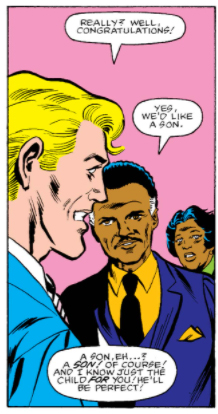 I'm pretty sure that that's not how adoption works, is it? Two quick other things about this story: firstly, somebody (possibly George Roussos, the colorist) seems to have realised that they can use colour without outlines, as the whole comic is full of images where a pink wash is used to denote memories or incursions from other realms.
I'm pretty sure that that's not how adoption works, is it? Two quick other things about this story: firstly, somebody (possibly George Roussos, the colorist) seems to have realised that they can use colour without outlines, as the whole comic is full of images where a pink wash is used to denote memories or incursions from other realms.
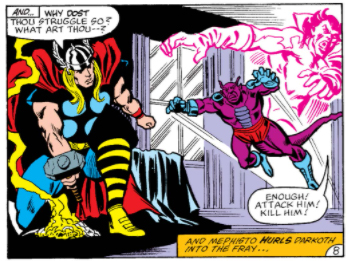 Secondly, Doug Moench and/or Allan Kupperberg have a surprisingly literal view of how you get from Hell back up to Earth!
Secondly, Doug Moench and/or Allan Kupperberg have a surprisingly literal view of how you get from Hell back up to Earth!
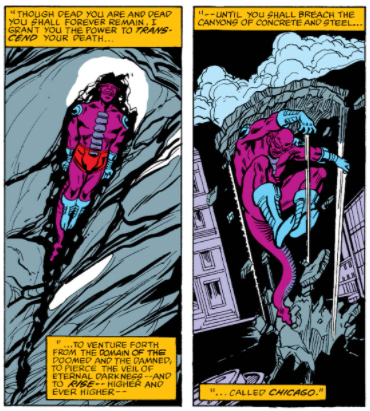 And that's the lot for this one I'm afraid. Come back next time when Doom will get a whole page to himself in a cameo in "Dr Strange" that will have long-lasting reverberations!
And that's the lot for this one I'm afraid. Come back next time when Doom will get a whole page to himself in a cameo in "Dr Strange" that will have long-lasting reverberations!
posted 29/9/2020 by MJ Hibbett
(click here for permanent link)
(0) comments
This Land Is Mine!
This is one of my all-time favourite comics stories EVER. I remember being amazed by it when it came out, re-reading it over and over, then being delighted to find it stood up many years later, in my original copy and then when I bought the trade paperback series of Byrne's run on Famtastic Four. In recent years I've been excited all over again to find that it's full of wrinkles and subtleties that I'd not noiced before, and have talked about it at conferences and included it in a paper about Marvel during the Cold War. It is, to put it in non-academic terms, a bloody brilliant comic!
The story itself starts with a huge splash page of Doom yelling the title.
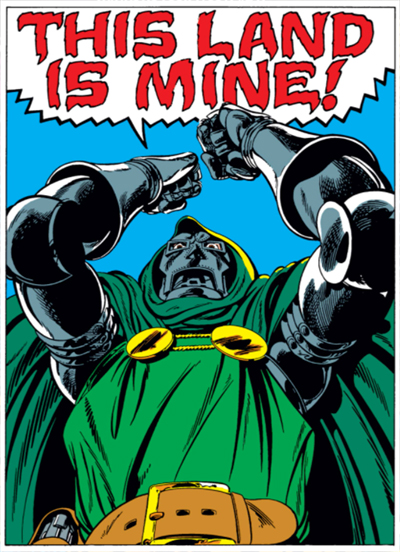 Here on the first pages the reader may take this to be Doom doing his usual cry of megalomania, but then when we turn over to the doube-page spread overleaf we find that he's actually explaining what's gone wrong in the ruined Latveria that we saw at the end of the previous issue. He tells the Fantastic Four that the runined nation around them is all because of their interference back in Fantastic Four #200, when they helped Prince Zorba take over the country. Under Doom, Latveria was stable and prosperous, but under Zorba it has fallen apart. The men of the FF refuse to believe this, with only Sue prepared to consider that he might be right.
Here on the first pages the reader may take this to be Doom doing his usual cry of megalomania, but then when we turn over to the doube-page spread overleaf we find that he's actually explaining what's gone wrong in the ruined Latveria that we saw at the end of the previous issue. He tells the Fantastic Four that the runined nation around them is all because of their interference back in Fantastic Four #200, when they helped Prince Zorba take over the country. Under Doom, Latveria was stable and prosperous, but under Zorba it has fallen apart. The men of the FF refuse to believe this, with only Sue prepared to consider that he might be right.
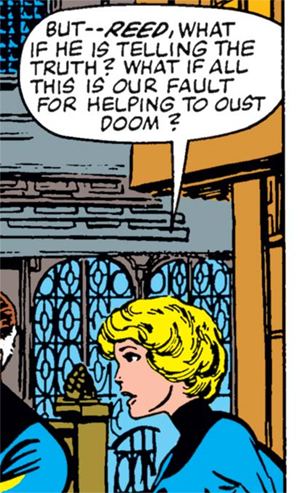 To twelve-year-old me, this was utterly mind-blowing - could Doom ruling a county actually be a Good Thing? To slightly-more-than-twelve-year-old me, this is a fascinating way of analysing then-current American foreign policy, which stated that sometimes it was better to have dictators in charge of a country than run the risk of it collapsing and becoming a rogue state. Actually, it could be argued that that's still the foreign policy for many Western Governments. Here John Byrne seems to be testing this to the limits - if the US government was prepared to keep Gadaffi in charge of a state in order to maintain stability, shouldn't that logic also mean that Doctor Doom should retain control of Latveria?
To twelve-year-old me, this was utterly mind-blowing - could Doom ruling a county actually be a Good Thing? To slightly-more-than-twelve-year-old me, this is a fascinating way of analysing then-current American foreign policy, which stated that sometimes it was better to have dictators in charge of a country than run the risk of it collapsing and becoming a rogue state. Actually, it could be argued that that's still the foreign policy for many Western Governments. Here John Byrne seems to be testing this to the limits - if the US government was prepared to keep Gadaffi in charge of a state in order to maintain stability, shouldn't that logic also mean that Doctor Doom should retain control of Latveria?
Doom's declaration of himself as a responsible ruler is tested right away when a small boy called Kristoff runs out and collides with him. Doom reacts angrily and the child's mother rushes out to beg for his life, just as you might expect from a civilian meeting a super-villain. However, the whole situation twists when she realises that it's not Zorba's secret police, as she'd thought, but "The Master".
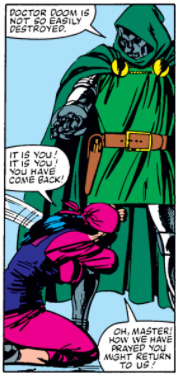 "Holy cow! She... she's glad to see him!" says the Human Torch, as the FF stand amazed at this turn of events. Kristoff's mum confirms Doom's story, that he was a beloved and competent ruler, and Byrne rather brilliantly illustrates it with a direct quote from Doom's origin story.
"Holy cow! She... she's glad to see him!" says the Human Torch, as the FF stand amazed at this turn of events. Kristoff's mum confirms Doom's story, that he was a beloved and competent ruler, and Byrne rather brilliantly illustrates it with a direct quote from Doom's origin story.
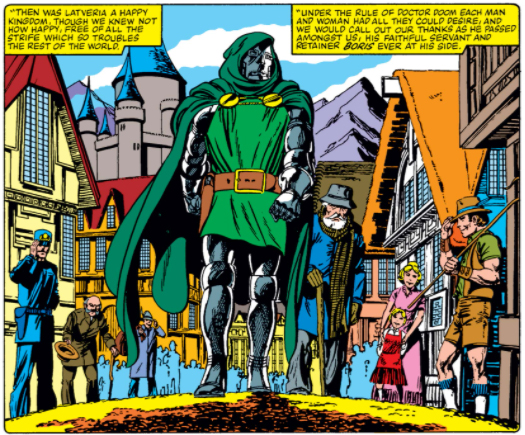
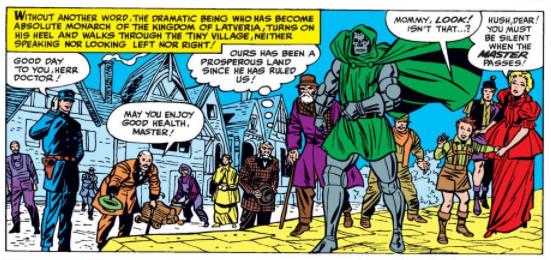 I only noticed that Byrne's image is a near-copy of Kirby's (drawn from a different angle) because I happened to read the two comics close together while preparing my PhD corpus, and the fact that it took me several decades to realise leads me to think Byrne might be doing this partly for his own amusement. It's clearly an intentional nod to the original, as so many of the characters are in the same positions, and it's definitely part of a trend in this issue for Byrne to quote previous stories in order to affirm that this is all part of the Doom that we know, but this particular homage feels more like an Easter Egg.
I only noticed that Byrne's image is a near-copy of Kirby's (drawn from a different angle) because I happened to read the two comics close together while preparing my PhD corpus, and the fact that it took me several decades to realise leads me to think Byrne might be doing this partly for his own amusement. It's clearly an intentional nod to the original, as so many of the characters are in the same positions, and it's definitely part of a trend in this issue for Byrne to quote previous stories in order to affirm that this is all part of the Doom that we know, but this particular homage feels more like an Easter Egg.
Kristoff's mum's story illustrates tells us that without the iron fist of Doom over them, the people of Latveria very quickly turned to lawlessness.
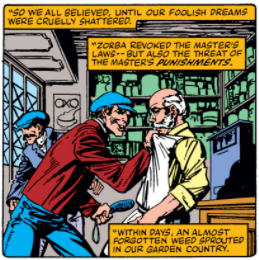 Byrne - or the American imperialist/exceptionalist foreign policy he's examining here - seem to be saying that democracy is all well and good for US citizens, but that other nations are not grown-up enough to cope with it, agnd need to be ruled firmly to stop them getting into trouble.
Byrne - or the American imperialist/exceptionalist foreign policy he's examining here - seem to be saying that democracy is all well and good for US citizens, but that other nations are not grown-up enough to cope with it, agnd need to be ruled firmly to stop them getting into trouble.
Doom's version of events is finally proven beyond doubt when some re-purposed Doombots appear and kill Kristoff's mum in cold blood. Doom reacts angrily and launches into battle to avenge her death, and the FF find themselves backing him up and, without really noticing, taking orders from him.
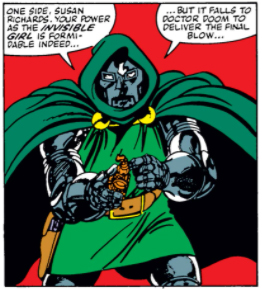 Once the robots are defeated Latverians come out of hiding and gratefully welcome Doom back, before leading him and the FF into a nearby pub, which The Thing recognises as a former base for the Latverian resistance. Again, this shows that everything we thought we knew has been flipped over, with Doom now cast as the plucky resistance fighter, while Zorba is the evil dictator.
Once the robots are defeated Latverians come out of hiding and gratefully welcome Doom back, before leading him and the FF into a nearby pub, which The Thing recognises as a former base for the Latverian resistance. Again, this shows that everything we thought we knew has been flipped over, with Doom now cast as the plucky resistance fighter, while Zorba is the evil dictator.
This is illustrated further by a trip into Zorba's headquarters, where we find him angrily decrying the stupidity of the Latverian people to his SS-like deputy, while a torture victim is dragged away.
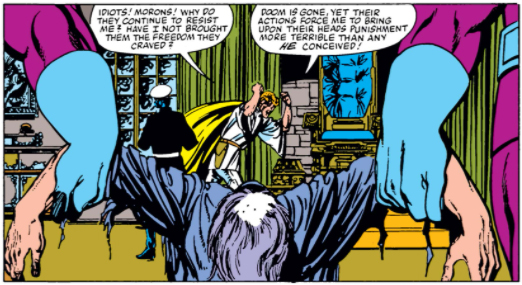 Zorba decides he's had enough of their ingratitude and unleashes weapons of mass destruction on his own people. Despite all the politics, howver, this is still a superhero comic, so that WMDs turn out to be Killer Robots.
Zorba decides he's had enough of their ingratitude and unleashes weapons of mass destruction on his own people. Despite all the politics, howver, this is still a superhero comic, so that WMDs turn out to be Killer Robots.
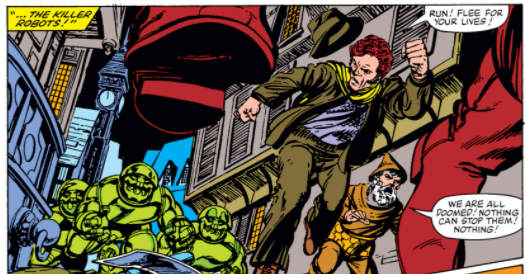 This is yet another continuity nod by Byrne, as these are the very same Killer Robots that we saw Doom himself unleashing on an unsuspecting populace back in Fantastic Four #85. Zorba's transformation into Doctor Doom is continuing.
This is yet another continuity nod by Byrne, as these are the very same Killer Robots that we saw Doom himself unleashing on an unsuspecting populace back in Fantastic Four #85. Zorba's transformation into Doctor Doom is continuing.
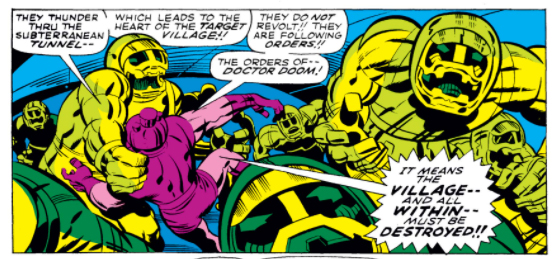 Battle commences, with Doom once again directing tactics, much to the consternation of Sue.
Battle commences, with Doom once again directing tactics, much to the consternation of Sue.
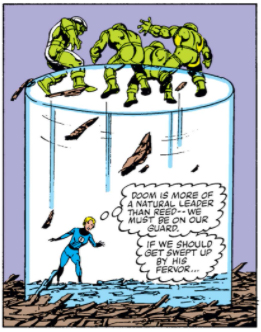 She's right to be concerned, as while they're dealing with the robots Doom makes his way to the castle. Here he rescuea his old friend Boris from the dungeons, then moves on to confronting Zorba, who reacts with an extremely telling remark.
She's right to be concerned, as while they're dealing with the robots Doom makes his way to the castle. Here he rescuea his old friend Boris from the dungeons, then moves on to confronting Zorba, who reacts with an extremely telling remark.
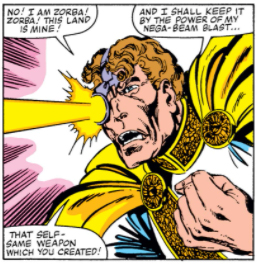 "This land is mine". OOF! I'd read this comic about twenty times over the years, but it was only recently that I realised exactly what was happening here. Zorba repeats Doom's statement at the very start of the story, signalling his complete transformation into the villain. Doom wastes very little time in dealing with his enemy, dangling him over a battlement where Zorba makes perhaps one of the most stupid statements ever.
"This land is mine". OOF! I'd read this comic about twenty times over the years, but it was only recently that I realised exactly what was happening here. Zorba repeats Doom's statement at the very start of the story, signalling his complete transformation into the villain. Doom wastes very little time in dealing with his enemy, dangling him over a battlement where Zorba makes perhaps one of the most stupid statements ever.
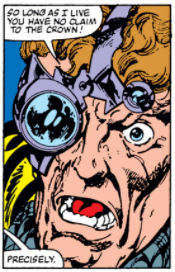 We don't see what happens next, but we find out on the next, and final, page.
We don't see what happens next, but we find out on the next, and final, page.
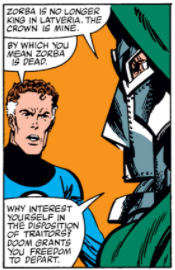 What is so great, to me, about this, is that there's no attempt to redeem Doom. He is, as he has always been, a murderous dictator who will let nothing stand in his way. Doom himself remains exactly as he has always been, only our view of him has changed over the course of this one issue. The story ends, as they usually do when Doom forms an alliance with anybody, with him declaring that he will let the FF leave, but that he will do his very best to destroy them when they next meet.
What is so great, to me, about this, is that there's no attempt to redeem Doom. He is, as he has always been, a murderous dictator who will let nothing stand in his way. Doom himself remains exactly as he has always been, only our view of him has changed over the course of this one issue. The story ends, as they usually do when Doom forms an alliance with anybody, with him declaring that he will let the FF leave, but that he will do his very best to destroy them when they next meet.
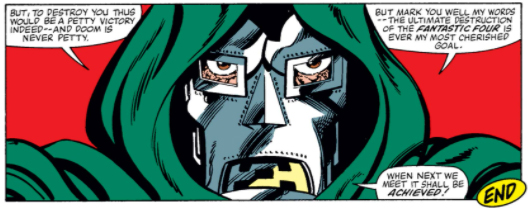 As I said at the start, when I first read this story I found it mind-blowing and exciting, and I still do for slightly different, or actually maybe just additional, reasons. John Byrne stays true to the character of Doctor Doom and brings in so much continuity that we can be in no doubt that he's the same individual we've always known, and then uses this to make us question our views on government and a people's right to liberty. The answers Byrne propose are not particularly palatable, perhaps, but the way he does it is supremely skilful.
As I said at the start, when I first read this story I found it mind-blowing and exciting, and I still do for slightly different, or actually maybe just additional, reasons. John Byrne stays true to the character of Doctor Doom and brings in so much continuity that we can be in no doubt that he's the same individual we've always known, and then uses this to make us question our views on government and a people's right to liberty. The answers Byrne propose are not particularly palatable, perhaps, but the way he does it is supremely skilful.
It's a great use of character coherence in a long-standing storyworld to cast new light on its inhabitants, and our world too, and that's part of the reason I love it so much. The fact that Byrne's art look so great doesn't hurt either!
posted 22/9/2020 by MJ Hibbett
(click here for permanent link)
(1) comments
Too Many Dooms
Last time we looked at an issue of Fantastic Four we were faced with an impenatrable mystery - we knew that Doctor Doom was trapped in a puppet body in Liddleville, but then we also saw Doctor Doom picking that body up, and then later giving orders to the Latverian ambassador. How could noted Robot-Builder and Duplicate-fiend Doctor Doom possibly be in more than one place at once?!?
Well obviously it's robots, but one of the many wonderful things about this extremely excellent comic is the way that John Byrne leads up to the "revelation", allowing the characters to work it out for themselves all at the same time, before going on to explore how this might all work. It's a great example of how his approach to the series worked, taking the best bits of the Lee/Kirby run, revamping where necessary, adding new aspects, but never forgetting to pay tribute to the originals. This is demonstrated with the cover too, which is a homage here to the cover of Fantastic Four #17.
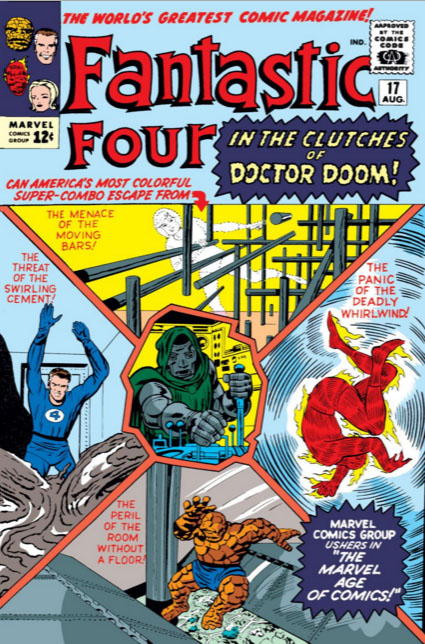 In Lee and Kirby's version Doom basically pitted the Fantastic Four against the unassailable might of... er... a building site, whereas Byrne takes the idea of splitting the team up and then makes it much more exciting. It's very similar to the way that Alan Moore used to take characters apart and then build them back up again, although I doubt either creator would appreciate the comparison.
In Lee and Kirby's version Doom basically pitted the Fantastic Four against the unassailable might of... er... a building site, whereas Byrne takes the idea of splitting the team up and then makes it much more exciting. It's very similar to the way that Alan Moore used to take characters apart and then build them back up again, although I doubt either creator would appreciate the comparison.
The story itself kicks off with Reed Richards having another attempt at curing Ben Grimm of being The Thing... or at least pretending to. He suspects that his friend believes that Alicia only loves him when he's The Thing, and so is subconsciously preventing any "cure" from working - a lovely idea that not only makes the characterisation more interesting, but also generates lots of further story ideas.
Reed's musings are interrupted by Sue, who, in a jarring return to her previous duties as secretary to the team, has the Latverian amassador on line three. The ambassador is calling to finalise arrangements for the delivery of Doom's comatose body while, unbeknownst to the FF, Doom himself is sitting in the same room.
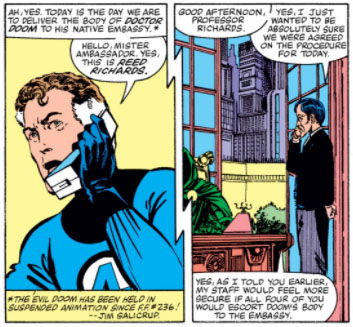 We then go over to Doom's New York castle, where we catch a glimpse of The Micronauts leaving after the end of their recent adventure in Liddleville. Byrne doesn't actually show The Micronauts themselves here, only the underside of their ship, thereby avoiding the copyright issues which means that The Micronaut's own series (and any guest appearances by them in other series) cannot be reprinted these days. I wonder if he did it this way on purpose?
We then go over to Doom's New York castle, where we catch a glimpse of The Micronauts leaving after the end of their recent adventure in Liddleville. Byrne doesn't actually show The Micronauts themselves here, only the underside of their ship, thereby avoiding the copyright issues which means that The Micronaut's own series (and any guest appearances by them in other series) cannot be reprinted these days. I wonder if he did it this way on purpose?
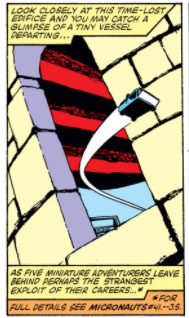 Inside a smaller version of this castle, within Liddleville itself, we see the Puppet Master taunting Doom, having trapped him there back in Micronauts #41. However, just as he's enjoying himself, who should suddenly appear looming above them but... Doctor Doom?!!
Inside a smaller version of this castle, within Liddleville itself, we see the Puppet Master taunting Doom, having trapped him there back in Micronauts #41. However, just as he's enjoying himself, who should suddenly appear looming above them but... Doctor Doom?!!
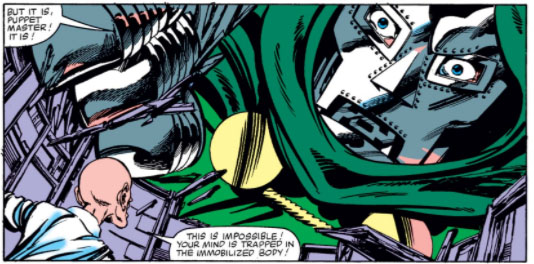 What the?!? How can Doom be in Liddleville, above Liddleville, and in the Embassy all at the same time? There's no time to ponder this though as we're taken immediately back to the Embassy where the ambassador very foolishly raises the possibility that Doom's latest cunning plan will fail. His boss does not take this idea in the constructive spirit in which it was intended, and once again demonstrates why the Latveria Embassy has won no awards for good Human Resources practice.
What the?!? How can Doom be in Liddleville, above Liddleville, and in the Embassy all at the same time? There's no time to ponder this though as we're taken immediately back to the Embassy where the ambassador very foolishly raises the possibility that Doom's latest cunning plan will fail. His boss does not take this idea in the constructive spirit in which it was intended, and once again demonstrates why the Latveria Embassy has won no awards for good Human Resources practice.
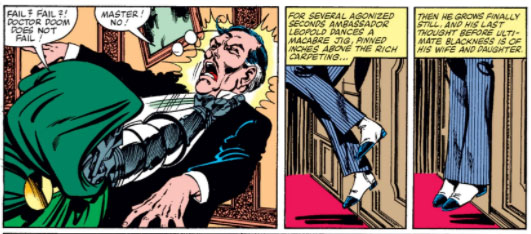 The FF arrive in the building and are immediately dropped into a series of pits, where they each have their powers neutralised before individually meeting Doom himself. Each member of the team gets their own mini-fight with Doom, during which they have to work out what's going on in their own way, eventually coming to the same conclusion at the same time as one another.
The FF arrive in the building and are immediately dropped into a series of pits, where they each have their powers neutralised before individually meeting Doom himself. Each member of the team gets their own mini-fight with Doom, during which they have to work out what's going on in their own way, eventually coming to the same conclusion at the same time as one another.
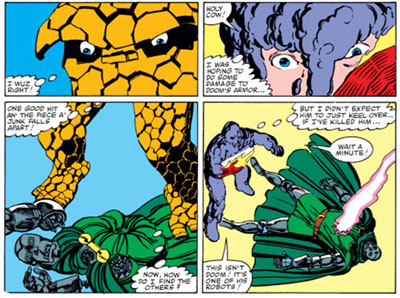 It's beautifully done - the reader will probably have worked this all out already, but seeing the FF seperately get there for themselves, in their own individual way, is a lovely bit of character work. With this "secret" now out in the open we get to see the various Doombots all gathering together, at which point they stop pretending to be Doom and work as a Robot Army.
It's beautifully done - the reader will probably have worked this all out already, but seeing the FF seperately get there for themselves, in their own individual way, is a lovely bit of character work. With this "secret" now out in the open we get to see the various Doombots all gathering together, at which point they stop pretending to be Doom and work as a Robot Army.
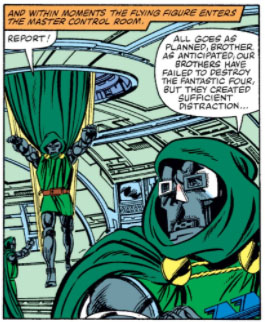 It's a great idea which I don't think has been seen before - we always knew Doom had lots of robot duplicates, but we've never seen how they might interact when they're all together. They return Doom's mind to his body and after a very brief sit-down he's back in charge, bossing the Fantastic Four around, completely unphased by their attempts to tell him off.
It's a great idea which I don't think has been seen before - we always knew Doom had lots of robot duplicates, but we've never seen how they might interact when they're all together. They return Doom's mind to his body and after a very brief sit-down he's back in charge, bossing the Fantastic Four around, completely unphased by their attempts to tell him off.
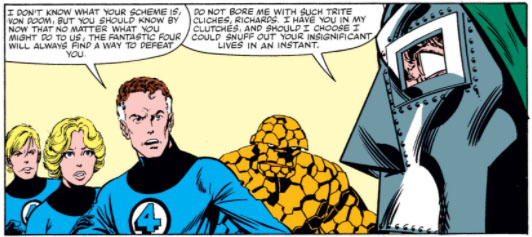 Doom reveals that he wants the FF to help him re-take the throne of Latveria, which they not unreasonably reject out of hand as an utterly crazy idea. "I did not expect immediate agreement", he says, and the issue ends with a dramatic splash page, showing that contrary to all expectations way back in Fantastic Four #200, deposing Doom from the throne has led to Latveria becoming a ruined wasteland.
Doom reveals that he wants the FF to help him re-take the throne of Latveria, which they not unreasonably reject out of hand as an utterly crazy idea. "I did not expect immediate agreement", he says, and the issue ends with a dramatic splash page, showing that contrary to all expectations way back in Fantastic Four #200, deposing Doom from the throne has led to Latveria becoming a ruined wasteland.
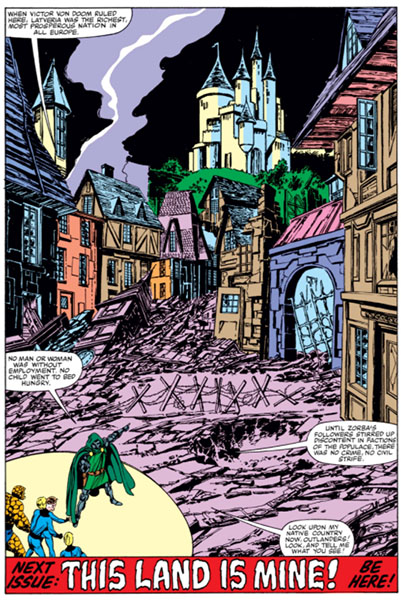 As I've said many times, I bought these comics when they first came out, and the idea that Doctor Doom's rule could have been beneficial to the people of Latveria was mind-blowing. I was so used to baddies being unremitting baddies, especially in American comics, that to see it even being suggested that Doom could be good for his people was incredible. It's one heck of a cliffhanger, and it leads into what I think is one of the greatest Doom stories ever. It's "This Land Is Mine", and we'll be looking at it next time!
As I've said many times, I bought these comics when they first came out, and the idea that Doctor Doom's rule could have been beneficial to the people of Latveria was mind-blowing. I was so used to baddies being unremitting baddies, especially in American comics, that to see it even being suggested that Doom could be good for his people was incredible. It's one heck of a cliffhanger, and it leads into what I think is one of the greatest Doom stories ever. It's "This Land Is Mine", and we'll be looking at it next time!
posted 17/9/2020 by MJ Hibbett
(click here for permanent link)
(0) comments
Spider-man Unmasked!
It feels like a long time since we last looked at an episode of "Spider-man And His Amazing Friends", the slightly dopey, sitcom-esque sibling to the plainly-titled (but much more exciting) "Spider-man" cartoon of the early 1980s. Doctor Doom played a major part in the latter, so it's a shame that that series only lasted for a single season, while "Spider-man and his Amazing Friends" went for three whole years.
As I said last time we looked at this show, I remember it as being a bit daft and rubbish, and this episode very much reaffirms that opinion. Spider-man, Firestar and Iceman seem to spend most of the episode in their civilian identities, in this case going to the beach (where they scare off a shark), popping to the pictures and then going to the zoo. In the midst of this is a storyline in which The Sandman learns Peter Parker's secret identity, so Firestar enlists the help of Flash Thompson to do the old "Peter stands next to someone in a Spider-man costume" trick to throw the villain of the scent.
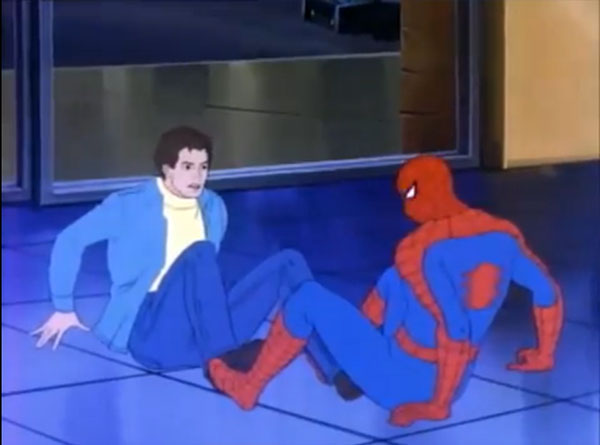 "Parker? And Spider-man? Together?" says The Sandman, and that's that sorted.
"Parker? And Spider-man? Together?" says The Sandman, and that's that sorted.
Doctor Doom appears only very briefly, when Flash and Firestar visit the aptly named "Stan's costumes" to pick up Flash's Spidey suit.
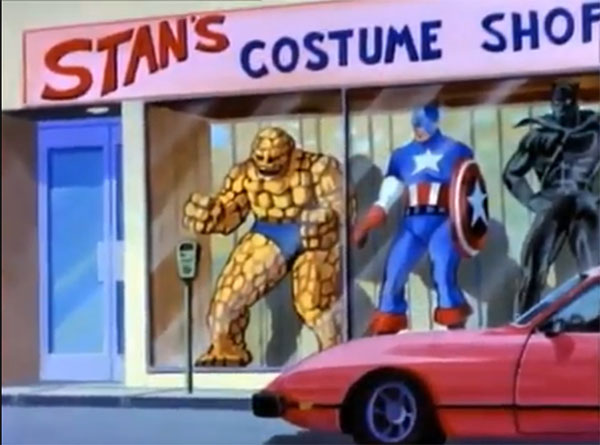 It's interesting that they've got a The Thing costume in the window - I would have guessed that rights issues would have meant that the Fantastic Four couldn't appear in this series, but then again the presence of Doom here indicates that they might? Either way, there's a Doctor Doom costume on display alongside a very much Of The Time range of superheroes, including Elektra and Dazzler.
It's interesting that they've got a The Thing costume in the window - I would have guessed that rights issues would have meant that the Fantastic Four couldn't appear in this series, but then again the presence of Doom here indicates that they might? Either way, there's a Doctor Doom costume on display alongside a very much Of The Time range of superheroes, including Elektra and Dazzler.
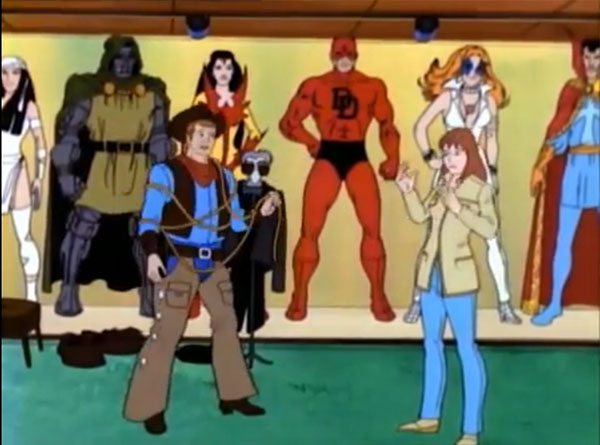 The Doom costume isn't mentioned and isn't really relevant to the story, although it is identical to the one seen in the title sequence, where Doom appears as the grand finale to the titles for each episode, despite only appearing in the actual show twice.
The Doom costume isn't mentioned and isn't really relevant to the story, although it is identical to the one seen in the title sequence, where Doom appears as the grand finale to the titles for each episode, despite only appearing in the actual show twice.
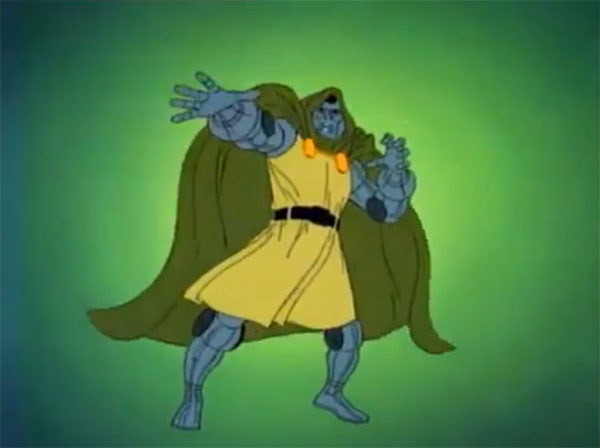 This highlighting of Doom, along with his presence in this episode alongside other leading characters (or, in the case of Dazzler, characters Marvel wanted to promote) demonstrates yet again that he's viewed as one of the major assets in the Marvel universe. I just wish that meant he'd been more a part of the actual show, especially as this is the last cartoon we'll be looking at in this corpus.
This highlighting of Doom, along with his presence in this episode alongside other leading characters (or, in the case of Dazzler, characters Marvel wanted to promote) demonstrates yet again that he's viewed as one of the major assets in the Marvel universe. I just wish that meant he'd been more a part of the actual show, especially as this is the last cartoon we'll be looking at in this corpus.
Next time, however, we're back to looking at Doom in the main Marvel Universe, in an actual comics - and a great comic too!
posted 15/9/2020 by MJ Hibbett
(click here for permanent link)
(0) comments
What If Doctor Doom Had A Sense Of Humour?
Long-term readers of this blog will know that there's one type of Marvel Comic I enjoy more than any other, and that is of course the Marvel Humour Comic. Oh! The wonderful hours I have spent chortling away at the hysterical possibilities of Marvel characters being played for laughs, and Oh! the number of times I have had to go to A&E to have my very SIDES sewn up again as a result.
Aha! I was joking! For LO! when Marvel attempts to do humour, from Not Brand Echh to The Fantastic Four Roast it is about as funny as a slap in the face with a wet sock. So, you can understand my trepidation when I started reading this issue and found that all the usual suspects were present, including the Watcher being a twit, Fred Hembeck's heavily involved, there are single-panel puns and,of course, the never-ending hilarious possibilities of Aunt May being a superhero.
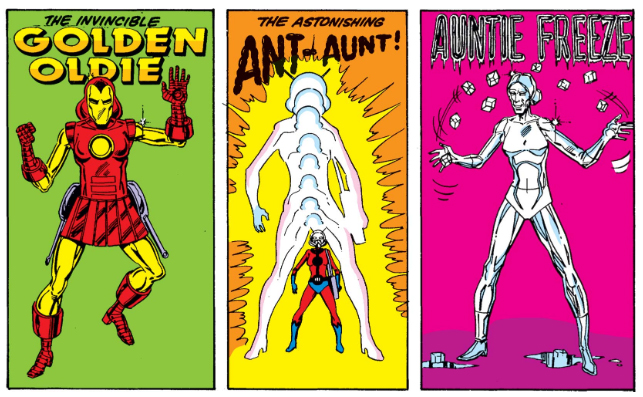 One thing that never seems to change, throughout this period of Marvel, is the fact that they think there's something inherently funny about Aunt May. There really isn't!
One thing that never seems to change, throughout this period of Marvel, is the fact that they think there's something inherently funny about Aunt May. There really isn't!
However, my general grumpiness at the prospect of reading this was thrown off balance when I came across a page I remembered very well indeed, from when it was reprinted in Marvel UK's "The Daredevils" series. At the time it was home to Alan Moore and Alan Davis's "Captain Britain" series, and I distinctly remember it featuring the short gag strip called "What If Daredevil were deaf instead of blind?" At the time I thought it had been written by Alan Moore, which was an easy mistake to make as most of the rest of the comic was!
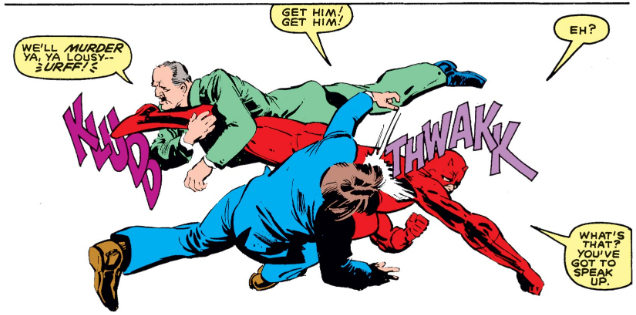 I have to admit, that joke did make me smile all these years later, and it almost makes up for "jokes" such as "What If Luke Cage had found the hammer of Thor?" (he would say "by the gleamin' gates of funky Asgard"...) and "What If Iron Man had an eating problem instead of a drinking problem ".
I have to admit, that joke did make me smile all these years later, and it almost makes up for "jokes" such as "What If Luke Cage had found the hammer of Thor?" (he would say "by the gleamin' gates of funky Asgard"...) and "What If Iron Man had an eating problem instead of a drinking problem ".
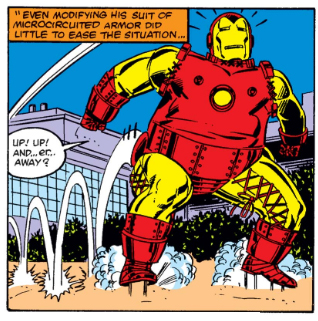 Doctor Doom appears twice in this comic. The first is on the cover, where he's pictured wearing a mask and stethoscope because - HO HO! - he is a Doctor!!!
Doctor Doom appears twice in this comic. The first is on the cover, where he's pictured wearing a mask and stethoscope because - HO HO! - he is a Doctor!!!
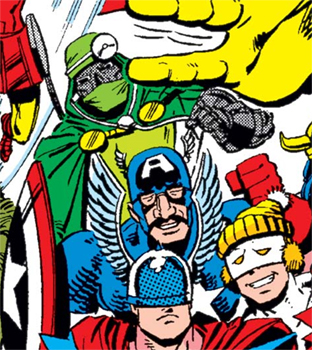 The second is right at the end, when we have a one-panel gag "What if Dr. Doom had a sense of humor?"
The second is right at the end, when we have a one-panel gag "What if Dr. Doom had a sense of humor?"
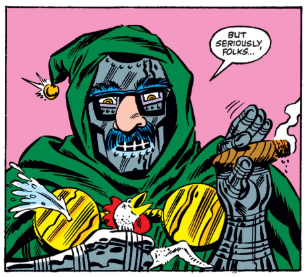 It's a load of old rubbish, but it's (almost) interesting to note that, fifteen years after his appearances in Brand Ecch, there's still an assumption that Doctor Doom's po-faced villainy is so well-accepted that placing him in any other situation is a surefire route to comedy gold.
It's a load of old rubbish, but it's (almost) interesting to note that, fifteen years after his appearances in Brand Ecch, there's still an assumption that Doctor Doom's po-faced villainy is so well-accepted that placing him in any other situation is a surefire route to comedy gold.
Thankfully, for me at least, this is the last time we'll have to look at Marvel's full-on attempts at a humour comic, although there are still plenty of jokes to come!
posted 10/9/2020 by MJ Hibbett
(click here for permanent link)
(0) comments
Home Again, Home Again, Jiggety-Jig!
Doom only appears in a single panel of this story, as part of a recap of the Micronauts' recent adventures.
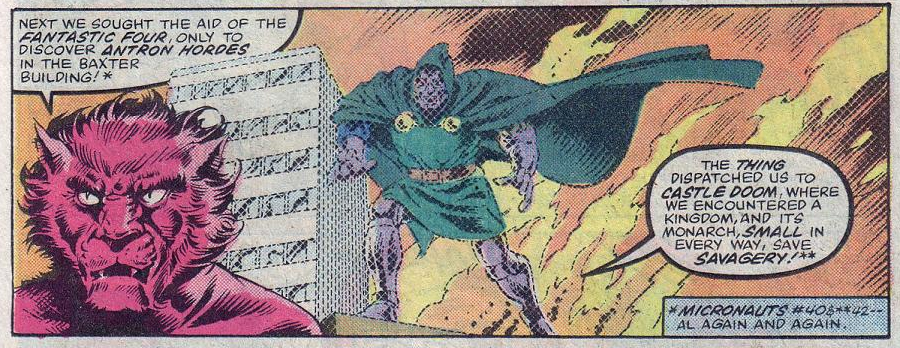 There's not really much else to say, except that the rest of the comic is another cracking issue of a surprisingly enjoyable series, gloriously illustrated by Gil Kane with full-on superhero storytelling by Bill Mantlo. Could this series be one of those "lost classics" you hear about?
There's not really much else to say, except that the rest of the comic is another cracking issue of a surprisingly enjoyable series, gloriously illustrated by Gil Kane with full-on superhero storytelling by Bill Mantlo. Could this series be one of those "lost classics" you hear about?
Anyway, join us next time for a comic which is definitely not a lost classic, as "What If?" does perhaps my least favourite kind of Marvel story - yes, it's "humour" time once again!
posted 8/9/2020 by MJ Hibbett
(click here for permanent link)
(0) comments
Prolog One
With the survey results FULLY examined it's time to get week back to the actual texts today, with a rather wonderful John Byrne issue of the FF which sees him very gently preparing for one of the greatest (in my opinion!) Doctor Doom stories... ever!
Most of the story here follows on from the previous issue, in which the FF finally managed to defeat Galactus, with Reed Richard now deciding that they have a duty to save him. This will lead to huge ramifications for the team later on, but for now the big change caused by it comes when Frankie Raye, the new female version of the Human Torch, volunteers to be Galactus's herald in exchange for him vowing not to eat the Earth.
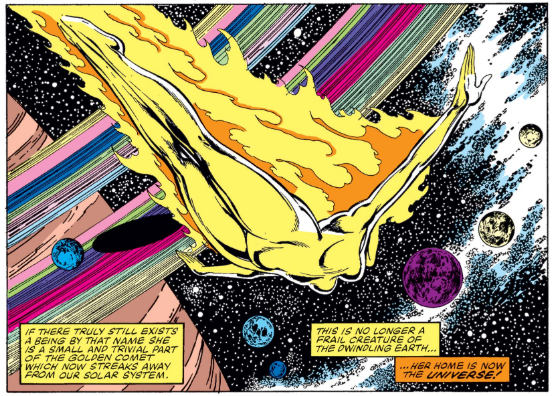 The Doctor Doom subplot appears right at the end of the issue, as part of "Prolog One", which seems an odd thing (and an odd spelling) to have at the end of a story. It starts off with Reed Richards finally buying the Baxter Building from their landlord, and then remembering that they've got Doctor Doom stored in one of their labs.
The Doctor Doom subplot appears right at the end of the issue, as part of "Prolog One", which seems an odd thing (and an odd spelling) to have at the end of a story. It starts off with Reed Richards finally buying the Baxter Building from their landlord, and then remembering that they've got Doctor Doom stored in one of their labs.
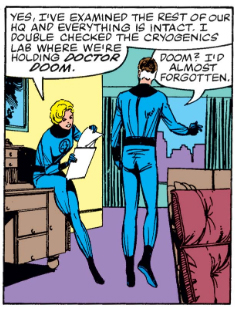 This seems an odd thing to forget about, but anyway, he rings the Latverian embassy and speaks to Ambassador Leopold. "What's that?" the diplomat says. "You say you are holding our former monarch, and want to know what we wish you to do?" He seems very calm about such an unusual telephonic opening gambit, but I suppose that when you're the ambassador for Latveria you get used to that sort of thing.
This seems an odd thing to forget about, but anyway, he rings the Latverian embassy and speaks to Ambassador Leopold. "What's that?" the diplomat says. "You say you are holding our former monarch, and want to know what we wish you to do?" He seems very calm about such an unusual telephonic opening gambit, but I suppose that when you're the ambassador for Latveria you get used to that sort of thing.
Reed explains that Doom is "locked into a suspended animation field. No, it was an accident - his own", and Leopold agrees to take delivery of Doom's body on Thursday. It's all massively pedestiran until we get to the final panel on the page when it's revealed that Doom himself has been there all along!
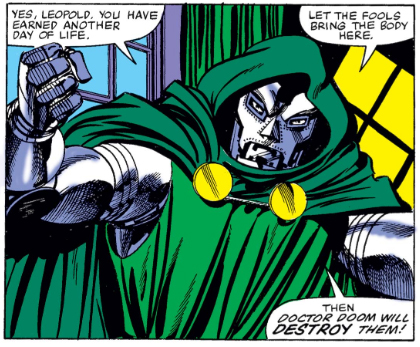 What the?!? How is this even possible? I for one can definitely not think of any way that Doctor Doom could be in two places at once, so I guess we'll just have to wait until the next time we're back in "The Fantastic Four" to find out what possible explanation there can be!
What the?!? How is this even possible? I for one can definitely not think of any way that Doctor Doom could be in two places at once, so I guess we'll just have to wait until the next time we're back in "The Fantastic Four" to find out what possible explanation there can be!
posted 3/9/2020 by MJ Hibbett
(click here for permanent link)
(0) comments